Hematology Report: Stem Cell Transplantation for Malignancies
VerifiedAdded on 2022/12/29
|7
|1638
|81
Report
AI Summary
This report focuses on stem cell transplantation as a treatment for hematological malignancies. It begins with a historical overview, tracing the evolution of the procedure over the past fifty years, highlighting key milestones like the first successful transplant and the advancements in understanding hematopoiesis. The report then delves into the techniques used for evaluating and diagnosing these malignancies, emphasizing the role of genomic analysis, cytogenetic analysis, and gene expression profiling. It also discusses the types of defects that are detected, including leukemia and myelodysplastic syndromes. Furthermore, the report explores emerging technologies and research areas, such as immunoconjugates, T-cell checkpoint inhibitors, and adoptive T-cell therapy, showcasing the ongoing efforts to improve treatment outcomes. The report concludes by referencing key sources, providing a comprehensive overview of the current state of stem cell transplantation in hematology.

Running head: HAEMATOLOGY
HAEMATOLOGY
Name of the Student
Name of the university
Author’s note
HAEMATOLOGY
Name of the Student
Name of the university
Author’s note
Paraphrase This Document
Need a fresh take? Get an instant paraphrase of this document with our AI Paraphraser
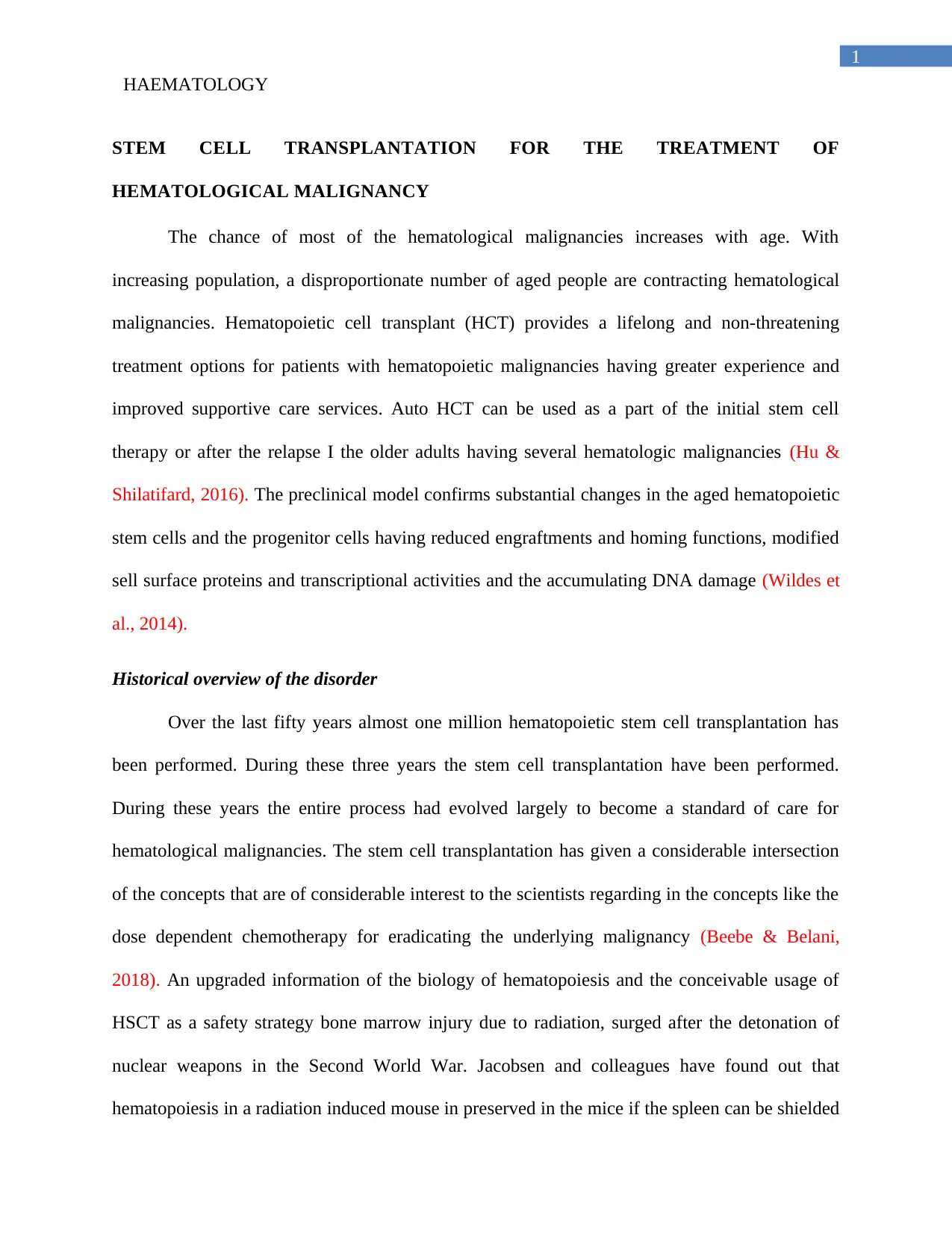
1
HAEMATOLOGY
STEM CELL TRANSPLANTATION FOR THE TREATMENT OF
HEMATOLOGICAL MALIGNANCY
The chance of most of the hematological malignancies increases with age. With
increasing population, a disproportionate number of aged people are contracting hematological
malignancies. Hematopoietic cell transplant (HCT) provides a lifelong and non-threatening
treatment options for patients with hematopoietic malignancies having greater experience and
improved supportive care services. Auto HCT can be used as a part of the initial stem cell
therapy or after the relapse I the older adults having several hematologic malignancies (Hu &
Shilatifard, 2016). The preclinical model confirms substantial changes in the aged hematopoietic
stem cells and the progenitor cells having reduced engraftments and homing functions, modified
sell surface proteins and transcriptional activities and the accumulating DNA damage (Wildes et
al., 2014).
Historical overview of the disorder
Over the last fifty years almost one million hematopoietic stem cell transplantation has
been performed. During these three years the stem cell transplantation have been performed.
During these years the entire process had evolved largely to become a standard of care for
hematological malignancies. The stem cell transplantation has given a considerable intersection
of the concepts that are of considerable interest to the scientists regarding in the concepts like the
dose dependent chemotherapy for eradicating the underlying malignancy (Beebe & Belani,
2018). An upgraded information of the biology of hematopoiesis and the conceivable usage of
HSCT as a safety strategy bone marrow injury due to radiation, surged after the detonation of
nuclear weapons in the Second World War. Jacobsen and colleagues have found out that
hematopoiesis in a radiation induced mouse in preserved in the mice if the spleen can be shielded
HAEMATOLOGY
STEM CELL TRANSPLANTATION FOR THE TREATMENT OF
HEMATOLOGICAL MALIGNANCY
The chance of most of the hematological malignancies increases with age. With
increasing population, a disproportionate number of aged people are contracting hematological
malignancies. Hematopoietic cell transplant (HCT) provides a lifelong and non-threatening
treatment options for patients with hematopoietic malignancies having greater experience and
improved supportive care services. Auto HCT can be used as a part of the initial stem cell
therapy or after the relapse I the older adults having several hematologic malignancies (Hu &
Shilatifard, 2016). The preclinical model confirms substantial changes in the aged hematopoietic
stem cells and the progenitor cells having reduced engraftments and homing functions, modified
sell surface proteins and transcriptional activities and the accumulating DNA damage (Wildes et
al., 2014).
Historical overview of the disorder
Over the last fifty years almost one million hematopoietic stem cell transplantation has
been performed. During these three years the stem cell transplantation have been performed.
During these years the entire process had evolved largely to become a standard of care for
hematological malignancies. The stem cell transplantation has given a considerable intersection
of the concepts that are of considerable interest to the scientists regarding in the concepts like the
dose dependent chemotherapy for eradicating the underlying malignancy (Beebe & Belani,
2018). An upgraded information of the biology of hematopoiesis and the conceivable usage of
HSCT as a safety strategy bone marrow injury due to radiation, surged after the detonation of
nuclear weapons in the Second World War. Jacobsen and colleagues have found out that
hematopoiesis in a radiation induced mouse in preserved in the mice if the spleen can be shielded
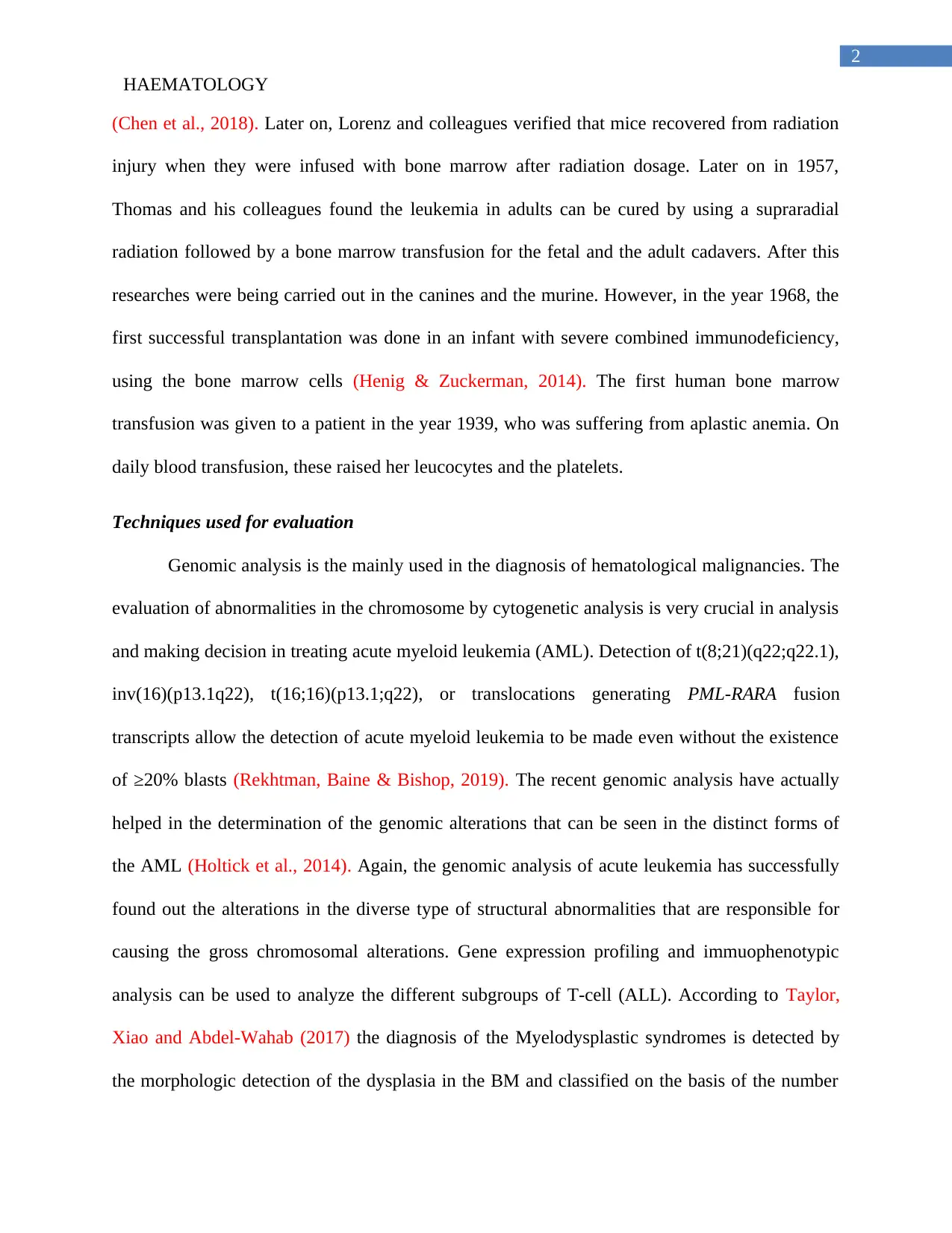
2
HAEMATOLOGY
(Chen et al., 2018). Later on, Lorenz and colleagues verified that mice recovered from radiation
injury when they were infused with bone marrow after radiation dosage. Later on in 1957,
Thomas and his colleagues found the leukemia in adults can be cured by using a supraradial
radiation followed by a bone marrow transfusion for the fetal and the adult cadavers. After this
researches were being carried out in the canines and the murine. However, in the year 1968, the
first successful transplantation was done in an infant with severe combined immunodeficiency,
using the bone marrow cells (Henig & Zuckerman, 2014). The first human bone marrow
transfusion was given to a patient in the year 1939, who was suffering from aplastic anemia. On
daily blood transfusion, these raised her leucocytes and the platelets.
Techniques used for evaluation
Genomic analysis is the mainly used in the diagnosis of hematological malignancies. The
evaluation of abnormalities in the chromosome by cytogenetic analysis is very crucial in analysis
and making decision in treating acute myeloid leukemia (AML). Detection of t(8;21)(q22;q22.1),
inv(16)(p13.1q22), t(16;16)(p13.1;q22), or translocations generating PML-RARA fusion
transcripts allow the detection of acute myeloid leukemia to be made even without the existence
of ≥20% blasts (Rekhtman, Baine & Bishop, 2019). The recent genomic analysis have actually
helped in the determination of the genomic alterations that can be seen in the distinct forms of
the AML (Holtick et al., 2014). Again, the genomic analysis of acute leukemia has successfully
found out the alterations in the diverse type of structural abnormalities that are responsible for
causing the gross chromosomal alterations. Gene expression profiling and immuophenotypic
analysis can be used to analyze the different subgroups of T-cell (ALL). According to Taylor,
Xiao and Abdel-Wahab (2017) the diagnosis of the Myelodysplastic syndromes is detected by
the morphologic detection of the dysplasia in the BM and classified on the basis of the number
HAEMATOLOGY
(Chen et al., 2018). Later on, Lorenz and colleagues verified that mice recovered from radiation
injury when they were infused with bone marrow after radiation dosage. Later on in 1957,
Thomas and his colleagues found the leukemia in adults can be cured by using a supraradial
radiation followed by a bone marrow transfusion for the fetal and the adult cadavers. After this
researches were being carried out in the canines and the murine. However, in the year 1968, the
first successful transplantation was done in an infant with severe combined immunodeficiency,
using the bone marrow cells (Henig & Zuckerman, 2014). The first human bone marrow
transfusion was given to a patient in the year 1939, who was suffering from aplastic anemia. On
daily blood transfusion, these raised her leucocytes and the platelets.
Techniques used for evaluation
Genomic analysis is the mainly used in the diagnosis of hematological malignancies. The
evaluation of abnormalities in the chromosome by cytogenetic analysis is very crucial in analysis
and making decision in treating acute myeloid leukemia (AML). Detection of t(8;21)(q22;q22.1),
inv(16)(p13.1q22), t(16;16)(p13.1;q22), or translocations generating PML-RARA fusion
transcripts allow the detection of acute myeloid leukemia to be made even without the existence
of ≥20% blasts (Rekhtman, Baine & Bishop, 2019). The recent genomic analysis have actually
helped in the determination of the genomic alterations that can be seen in the distinct forms of
the AML (Holtick et al., 2014). Again, the genomic analysis of acute leukemia has successfully
found out the alterations in the diverse type of structural abnormalities that are responsible for
causing the gross chromosomal alterations. Gene expression profiling and immuophenotypic
analysis can be used to analyze the different subgroups of T-cell (ALL). According to Taylor,
Xiao and Abdel-Wahab (2017) the diagnosis of the Myelodysplastic syndromes is detected by
the morphologic detection of the dysplasia in the BM and classified on the basis of the number
⊘ This is a preview!⊘
Do you want full access?
Subscribe today to unlock all pages.

Trusted by 1+ million students worldwide
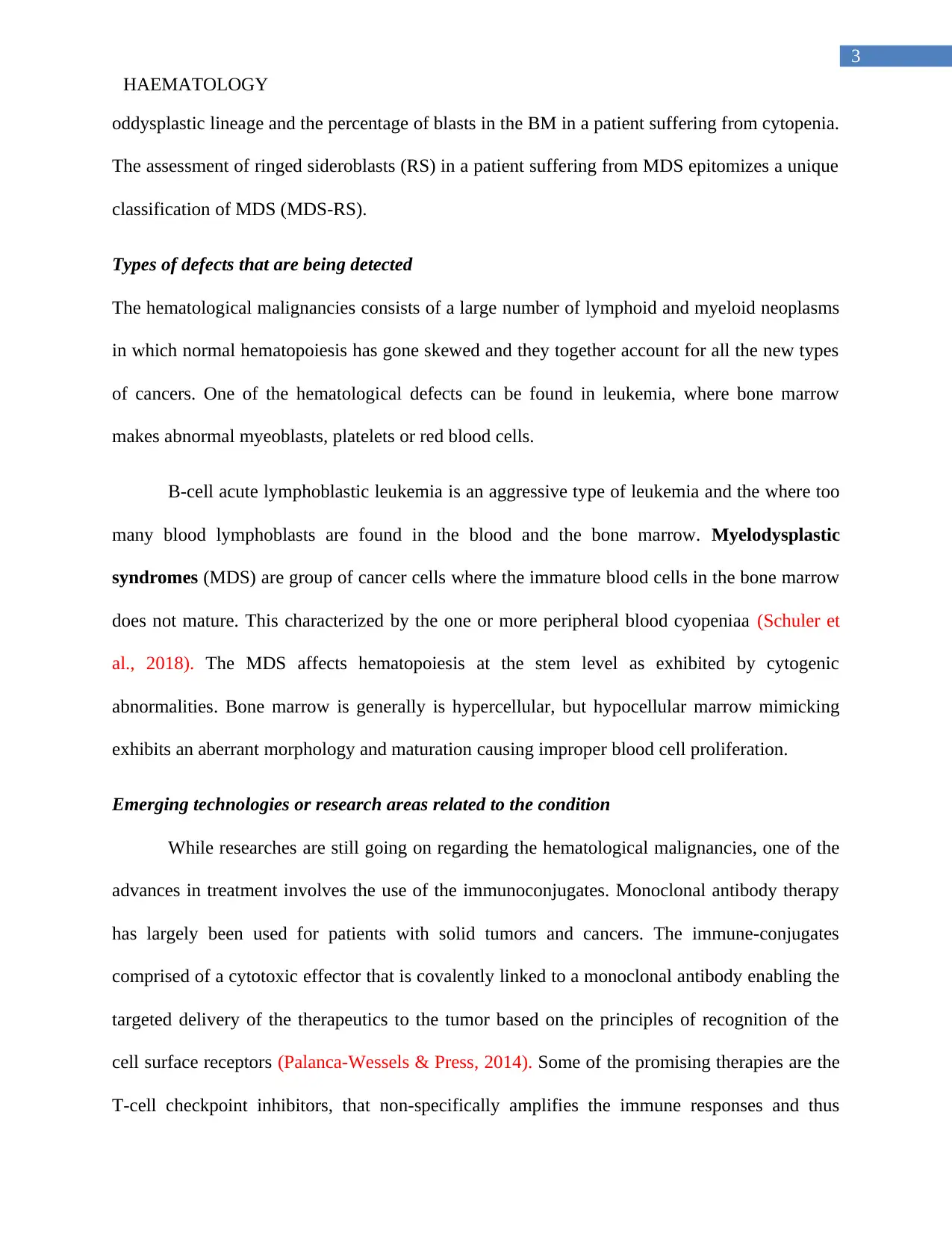
3
HAEMATOLOGY
oddysplastic lineage and the percentage of blasts in the BM in a patient suffering from cytopenia.
The assessment of ringed sideroblasts (RS) in a patient suffering from MDS epitomizes a unique
classification of MDS (MDS-RS).
Types of defects that are being detected
The hematological malignancies consists of a large number of lymphoid and myeloid neoplasms
in which normal hematopoiesis has gone skewed and they together account for all the new types
of cancers. One of the hematological defects can be found in leukemia, where bone marrow
makes abnormal myeoblasts, platelets or red blood cells.
B-cell acute lymphoblastic leukemia is an aggressive type of leukemia and the where too
many blood lymphoblasts are found in the blood and the bone marrow. Myelodysplastic
syndromes (MDS) are group of cancer cells where the immature blood cells in the bone marrow
does not mature. This characterized by the one or more peripheral blood cyopeniaa (Schuler et
al., 2018). The MDS affects hematopoiesis at the stem level as exhibited by cytogenic
abnormalities. Bone marrow is generally is hypercellular, but hypocellular marrow mimicking
exhibits an aberrant morphology and maturation causing improper blood cell proliferation.
Emerging technologies or research areas related to the condition
While researches are still going on regarding the hematological malignancies, one of the
advances in treatment involves the use of the immunoconjugates. Monoclonal antibody therapy
has largely been used for patients with solid tumors and cancers. The immune-conjugates
comprised of a cytotoxic effector that is covalently linked to a monoclonal antibody enabling the
targeted delivery of the therapeutics to the tumor based on the principles of recognition of the
cell surface receptors (Palanca-Wessels & Press, 2014). Some of the promising therapies are the
T-cell checkpoint inhibitors, that non-specifically amplifies the immune responses and thus
HAEMATOLOGY
oddysplastic lineage and the percentage of blasts in the BM in a patient suffering from cytopenia.
The assessment of ringed sideroblasts (RS) in a patient suffering from MDS epitomizes a unique
classification of MDS (MDS-RS).
Types of defects that are being detected
The hematological malignancies consists of a large number of lymphoid and myeloid neoplasms
in which normal hematopoiesis has gone skewed and they together account for all the new types
of cancers. One of the hematological defects can be found in leukemia, where bone marrow
makes abnormal myeoblasts, platelets or red blood cells.
B-cell acute lymphoblastic leukemia is an aggressive type of leukemia and the where too
many blood lymphoblasts are found in the blood and the bone marrow. Myelodysplastic
syndromes (MDS) are group of cancer cells where the immature blood cells in the bone marrow
does not mature. This characterized by the one or more peripheral blood cyopeniaa (Schuler et
al., 2018). The MDS affects hematopoiesis at the stem level as exhibited by cytogenic
abnormalities. Bone marrow is generally is hypercellular, but hypocellular marrow mimicking
exhibits an aberrant morphology and maturation causing improper blood cell proliferation.
Emerging technologies or research areas related to the condition
While researches are still going on regarding the hematological malignancies, one of the
advances in treatment involves the use of the immunoconjugates. Monoclonal antibody therapy
has largely been used for patients with solid tumors and cancers. The immune-conjugates
comprised of a cytotoxic effector that is covalently linked to a monoclonal antibody enabling the
targeted delivery of the therapeutics to the tumor based on the principles of recognition of the
cell surface receptors (Palanca-Wessels & Press, 2014). Some of the promising therapies are the
T-cell checkpoint inhibitors, that non-specifically amplifies the immune responses and thus
Paraphrase This Document
Need a fresh take? Get an instant paraphrase of this document with our AI Paraphraser
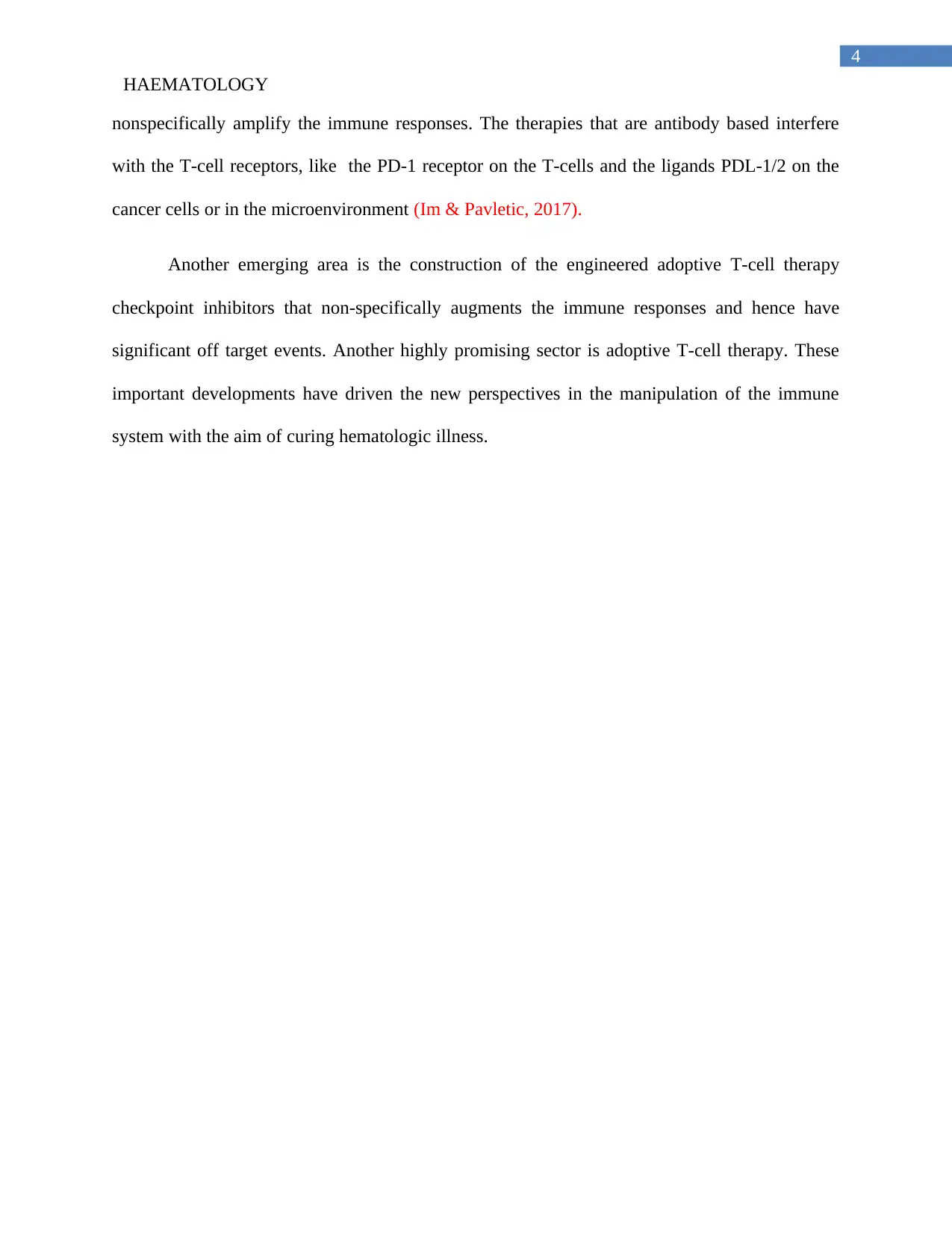
4
HAEMATOLOGY
nonspecifically amplify the immune responses. The therapies that are antibody based interfere
with the T-cell receptors, like the PD-1 receptor on the T-cells and the ligands PDL-1/2 on the
cancer cells or in the microenvironment (Im & Pavletic, 2017).
Another emerging area is the construction of the engineered adoptive T-cell therapy
checkpoint inhibitors that non-specifically augments the immune responses and hence have
significant off target events. Another highly promising sector is adoptive T-cell therapy. These
important developments have driven the new perspectives in the manipulation of the immune
system with the aim of curing hematologic illness.
HAEMATOLOGY
nonspecifically amplify the immune responses. The therapies that are antibody based interfere
with the T-cell receptors, like the PD-1 receptor on the T-cells and the ligands PDL-1/2 on the
cancer cells or in the microenvironment (Im & Pavletic, 2017).
Another emerging area is the construction of the engineered adoptive T-cell therapy
checkpoint inhibitors that non-specifically augments the immune responses and hence have
significant off target events. Another highly promising sector is adoptive T-cell therapy. These
important developments have driven the new perspectives in the manipulation of the immune
system with the aim of curing hematologic illness.
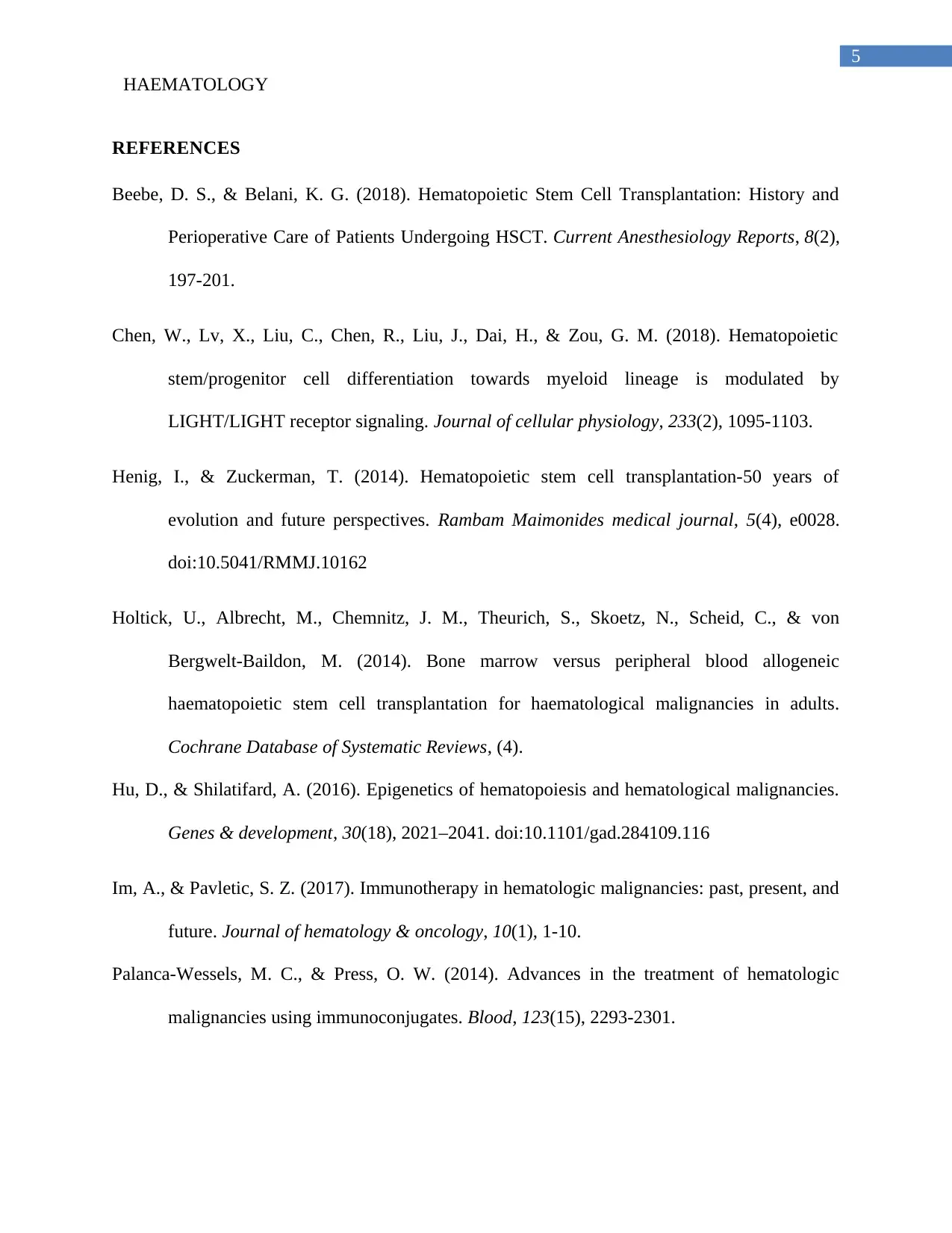
5
HAEMATOLOGY
REFERENCES
Beebe, D. S., & Belani, K. G. (2018). Hematopoietic Stem Cell Transplantation: History and
Perioperative Care of Patients Undergoing HSCT. Current Anesthesiology Reports, 8(2),
197-201.
Chen, W., Lv, X., Liu, C., Chen, R., Liu, J., Dai, H., & Zou, G. M. (2018). Hematopoietic
stem/progenitor cell differentiation towards myeloid lineage is modulated by
LIGHT/LIGHT receptor signaling. Journal of cellular physiology, 233(2), 1095-1103.
Henig, I., & Zuckerman, T. (2014). Hematopoietic stem cell transplantation-50 years of
evolution and future perspectives. Rambam Maimonides medical journal, 5(4), e0028.
doi:10.5041/RMMJ.10162
Holtick, U., Albrecht, M., Chemnitz, J. M., Theurich, S., Skoetz, N., Scheid, C., & von
Bergwelt‐Baildon, M. (2014). Bone marrow versus peripheral blood allogeneic
haematopoietic stem cell transplantation for haematological malignancies in adults.
Cochrane Database of Systematic Reviews, (4).
Hu, D., & Shilatifard, A. (2016). Epigenetics of hematopoiesis and hematological malignancies.
Genes & development, 30(18), 2021–2041. doi:10.1101/gad.284109.116
Im, A., & Pavletic, S. Z. (2017). Immunotherapy in hematologic malignancies: past, present, and
future. Journal of hematology & oncology, 10(1), 1-10.
Palanca-Wessels, M. C., & Press, O. W. (2014). Advances in the treatment of hematologic
malignancies using immunoconjugates. Blood, 123(15), 2293-2301.
HAEMATOLOGY
REFERENCES
Beebe, D. S., & Belani, K. G. (2018). Hematopoietic Stem Cell Transplantation: History and
Perioperative Care of Patients Undergoing HSCT. Current Anesthesiology Reports, 8(2),
197-201.
Chen, W., Lv, X., Liu, C., Chen, R., Liu, J., Dai, H., & Zou, G. M. (2018). Hematopoietic
stem/progenitor cell differentiation towards myeloid lineage is modulated by
LIGHT/LIGHT receptor signaling. Journal of cellular physiology, 233(2), 1095-1103.
Henig, I., & Zuckerman, T. (2014). Hematopoietic stem cell transplantation-50 years of
evolution and future perspectives. Rambam Maimonides medical journal, 5(4), e0028.
doi:10.5041/RMMJ.10162
Holtick, U., Albrecht, M., Chemnitz, J. M., Theurich, S., Skoetz, N., Scheid, C., & von
Bergwelt‐Baildon, M. (2014). Bone marrow versus peripheral blood allogeneic
haematopoietic stem cell transplantation for haematological malignancies in adults.
Cochrane Database of Systematic Reviews, (4).
Hu, D., & Shilatifard, A. (2016). Epigenetics of hematopoiesis and hematological malignancies.
Genes & development, 30(18), 2021–2041. doi:10.1101/gad.284109.116
Im, A., & Pavletic, S. Z. (2017). Immunotherapy in hematologic malignancies: past, present, and
future. Journal of hematology & oncology, 10(1), 1-10.
Palanca-Wessels, M. C., & Press, O. W. (2014). Advances in the treatment of hematologic
malignancies using immunoconjugates. Blood, 123(15), 2293-2301.
⊘ This is a preview!⊘
Do you want full access?
Subscribe today to unlock all pages.

Trusted by 1+ million students worldwide
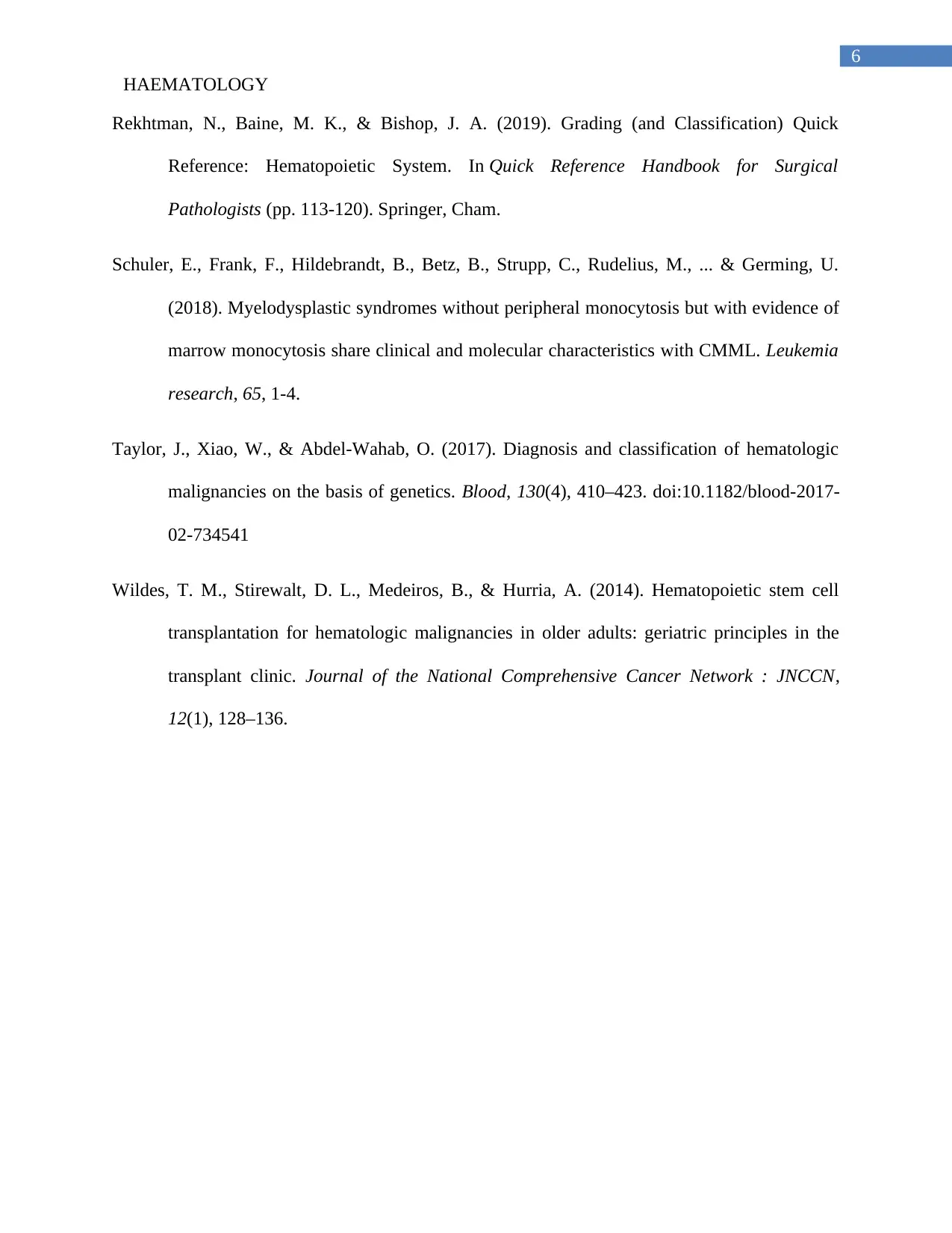
6
HAEMATOLOGY
Rekhtman, N., Baine, M. K., & Bishop, J. A. (2019). Grading (and Classification) Quick
Reference: Hematopoietic System. In Quick Reference Handbook for Surgical
Pathologists (pp. 113-120). Springer, Cham.
Schuler, E., Frank, F., Hildebrandt, B., Betz, B., Strupp, C., Rudelius, M., ... & Germing, U.
(2018). Myelodysplastic syndromes without peripheral monocytosis but with evidence of
marrow monocytosis share clinical and molecular characteristics with CMML. Leukemia
research, 65, 1-4.
Taylor, J., Xiao, W., & Abdel-Wahab, O. (2017). Diagnosis and classification of hematologic
malignancies on the basis of genetics. Blood, 130(4), 410–423. doi:10.1182/blood-2017-
02-734541
Wildes, T. M., Stirewalt, D. L., Medeiros, B., & Hurria, A. (2014). Hematopoietic stem cell
transplantation for hematologic malignancies in older adults: geriatric principles in the
transplant clinic. Journal of the National Comprehensive Cancer Network : JNCCN,
12(1), 128–136.
HAEMATOLOGY
Rekhtman, N., Baine, M. K., & Bishop, J. A. (2019). Grading (and Classification) Quick
Reference: Hematopoietic System. In Quick Reference Handbook for Surgical
Pathologists (pp. 113-120). Springer, Cham.
Schuler, E., Frank, F., Hildebrandt, B., Betz, B., Strupp, C., Rudelius, M., ... & Germing, U.
(2018). Myelodysplastic syndromes without peripheral monocytosis but with evidence of
marrow monocytosis share clinical and molecular characteristics with CMML. Leukemia
research, 65, 1-4.
Taylor, J., Xiao, W., & Abdel-Wahab, O. (2017). Diagnosis and classification of hematologic
malignancies on the basis of genetics. Blood, 130(4), 410–423. doi:10.1182/blood-2017-
02-734541
Wildes, T. M., Stirewalt, D. L., Medeiros, B., & Hurria, A. (2014). Hematopoietic stem cell
transplantation for hematologic malignancies in older adults: geriatric principles in the
transplant clinic. Journal of the National Comprehensive Cancer Network : JNCCN,
12(1), 128–136.
1 out of 7
Your All-in-One AI-Powered Toolkit for Academic Success.
+13062052269
info@desklib.com
Available 24*7 on WhatsApp / Email
![[object Object]](/_next/static/media/star-bottom.7253800d.svg)
Unlock your academic potential
Copyright © 2020–2025 A2Z Services. All Rights Reserved. Developed and managed by ZUCOL.
